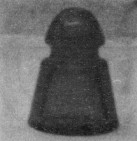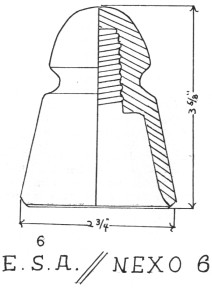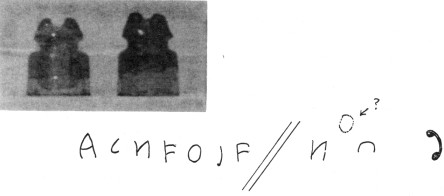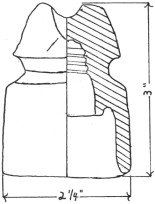Foreign Insulators
by Marilyn Albers
Reprinted from "INSULATORS - Crown Jewels of the Wire", May 1980, page 4
New Finds
First of all, I'd like to correct an error that
appeared in my article on New Zealand in the January 1980 issue of Crown
Jewels.
This was my fault. When I talk, I mumble, and when I write, I jumble! I stated
that Lu Farin (Decatur, Texas) has a collection of 3,000 pictures. That word
should have read pitchers. She does have a magnificent collection of pitchers in
all sizes, shapes and colors, made of every conceivable material -- silver,
pewter, glass, straw, eggshells, tin, etc. She has right handed pitchers, left
handed pitchers, and pitchers with no handles at all. Sorry, Lu!
But the good
news is that during a recent visit to her house, we found the answer to a
question I'd asked in last month's article on NGK insulators from Japan. I was
puzzled as to who had manufactured a Japanese insulator with a sort of
triangular looking logo. Lu discovered that this same logo also appeared on some
of her insulators, but with the letters NGK included, plus the date of
manufacture. So now we know that NGK used this trademark as well as their usual
one. This probably could have depended on (1) the age of the insulator, (2) the
consumer for whom it was made, or (3) which of the four NGK plants manufactured
it. I don't know the answer to that.

New E.S.A. Find (Esperanza Glass Factory,
Inc. - Spain)

I recently had the good fortune to add to my collection the
insulator pictured at the left. I'm really excited about this one. (Thanks, Pete
Bishop -- Columbus, Ohio.) It has no real CD number, because, to my knowledge,
it's never been listed; but it falls somewhere between CD 104 and CD 124.6. The
color of the glass is a real pretty green. (See sketch of this one on the
following page.)

The E.S.A. tells us that it is of Spanish manufacture,
but the NEXO-6 remains a mystery. Mr. Milholland's book on glass insulators does
list an E.S.A. CD 755 similarly marked NEXO-5, same color, which comes from
Africa, according to Bill Hungate (Klamath Falls, Oregon). Bill was responsible
for this insulator appearing in "the book" to begin with, so I have
him doing some sleuthing on this one to see if we can find out what NEXO means.
The CD 755 and this new find are the only two E.S.A. insulators we know of, so
far, that bear this word NEXO, and I'm assuming they both come from Africa. It
is possible that Nexo is the name of the supplier handling the insulators, or
the company for which they were made. It is probably a composite word, made up
of the first letters of several words. I would also assume that they were made
strictly for export, since most E.S.A. insulators have the standard one inch
American size pinhole, but these two have the typical small European size, about
3/4" in diameter.
In the midst of all this pondering, a letter arrived from
Mel and Marty Harder of Virginia Beach, Virginia, and I have their permission to
share it with you.
|
January 29, 1980
Dear Mrs. Albers,
We recently returned to
the States after living in Spain for several years. Having renewed my
subscription to Crown Jewels after letting it lapse for nearly four years, I was
delighted to receive the November issue and read your excellent article on
Spanish insulators. My wife and I thought that we were perhaps the only
collectors of Spanish glass, but that is what we get for not keeping our
"CJ" subscription up to date and thereby in touch with the rest of the
world! Your article was most informative and accurate in all respects based on
what we learned through the experience of combing the Spanish countryside for
insulators during our stay there.
Of all the pictures and listings in your
article there was only one item that we had not seen or are familiar with. That
being the CD 755 embossed ESA/NEXO-5. I cannot recall ever seeing it in use on
the Spanish lines, nor do I remember seeing it at the Esperanza glass factory. I
have some catalogs from the Scovi company of Madrid which handles the
distribution for Esperanza, and it is not listed as a current item. So if you
get a chance I would love to hear more about the CD 755 in regards to use, age,
etc.
The CD 803 shown from Mrs. Farin's collection is indeed a nice piece. Have
seen them in several colors such as dark green, aqua, pale green and also brown
and white ceramic. They are used as a dead end insulator. In the two holes at
the top are two threaded bolts with nuts on each end. The line wire wraps around
the groove and connects to the bolt. Then it runs to the transformer or house
wire from the other side of the bolt. Have seen a nearly identical French
insulator marked ELECTRO VERRE in use in Spain and Morocco.
It may be
that the CD 800/802 reported by Mr. Shiels are French. There are several styles
of French and German as well as American glass in use in Spain. My son found a
nice ISOREX gingerbread man on a pole in Cadiz. In talking to some old timers
from the Spanish phone company, they believe the reason for so much foreign
glass in Spain is due to the widespread destruction and rebuilding that took
place during the 1936 civil war. As a matter of fact, one of the frequent finds
over there is our old friend the Hemingray 42! I climbed many a rather shaky
pole looking for a special find only to come down with a Hemingray.
The CD 154
is one of the most common long distance telephone and telegraph insulators in
use. Most are E.S.A. model number 1 with round drips, but if you look hard
enough you can sometimes find their model number 7 with a smooth base. They are
nearly the same except the model #7 is about 7mm shorter and 7 mm narrower. CTNE
(the telephone company) seemed to use mostly the #1 but RENFE (Red Railroad)
sometimes used the smooth #7. Both models are still being made by E.S.A.
I am
enclosing some snapshots of "aisladores" in action. The one I have
marked #1 is what I believe to be rather scarce. In all my travels I only saw or
found the two we got from a fallen down abandoned line way back in the mountains
near Granada. If you have seen any of these I would appreciate hearing about
them. They are almost a 7-up green and are unembossed on the outside. I may
separate one of them to see if the top of the inside piece is marked.
Well guess
I have rambled on long enough. Mrs. Albers, I would like to have the snapshots
returned as I long ago lost the negatives. Hope to hear from you regarding the
CD 755.
Sincerely yours,
Mel Harder
|
I am having copies made of the pictures he sent and
will include them in a future article. I sent him a picture of the latest E.S.A.
find (NEXO-6) shown above. During a phone call that followed, he said he had
seen these in use in Ceuta (Say-u-ta), Spanish Morocco, on low voltage power
lines going into houses! So we may have solved the mystery of where in Africa,
at least. What could make more sense? At any rate, we will keep you posted. If
you're up on your geography, you probably know that in 1975 Spain lost her last
vestige of control in Africa when Spanish Morocco became part of Morocco proper
-- so it is no more. I feel myself getting hung up on Spanish insulators.
Hung upper and hung upper!
Bundesbahn (Railroad) Insulator -- West Germany.
As
you may remember, I have had some correspondence with Delores and Wayne Dixon in
Wiesbaden, West Germany. Wayne made a business trip back to the U.S.A. recently
and hand carried three insulators, which he mailed to me from Illinois; one from
Poland, one from Portugal, and the one you see pictured on the following page.
We swapped -- the Dixons now have an insulator from Russia, one from Iran, and a
Japanese porcelain!
The Bundesbahn insulator is used to supply power to
the German trains which are electric. The Dixons have several for swapping -- if
any of you get the chance to travel near Wiesbaden. The underglaze ink marking
on the crown shows the Rosenthal trademark. For information on Rosenthal
Industrial Ceramics, please see Matt Grayson's article on German insulators in
the June '79 issue of Crown Jewels. He did a lot of research on that one!
The
Big Mystery ??!!
I recently acquired two insulators from Grant Salzman of
Sacramento, California. These were originally among the group of Russian
porcelains and the Persian glass insulators (referred to in the December issue
of Crown Jewels) that were supplied by Kurdish tribesmen and then smuggled out
of the country! The two I refer to are pictured below. I have also made a rough
sketch of one of them on the following page.

These were both found on
Russian soil. The glass is a pretty honey color, but it is quite crude and
lopsided. They are actually very similar to the ones from Iran (Persia), but are
enough different to set them apart. One is unembossed. The other has some very
strange letters embossed on the skirt.

At first I thought these letters were
Russian, because of the backward N, but then I discovered the other letters did
not appear in the Russian alphabet. But just to make sure, I sent it to Donald
Fiene, a professor at the University of Tennessee, who teaches Russian and who
has made visits to that country. He has quite a collection of Russian insulators
himself. A short time later I received the following letter from him, which I
have his permission to print. Thanks, Don, for your efforts.
|
THE UNIVERSITY OF
TENNESSEE
KNOXVILLE 37916
Department of Germanic and Slavic Languages
Nov. 27,
1979
Dear Marilyn,
I have spent much time staring at the insulator you sent me
& trying to figure it out. I also have had two friends of mine look at it --
both of whom know Russian and were recently in the Middle East.
The
embossing on this insulator remains an absolute mystery. Our conclusion as to
the letters is exactly the same as your, except that we also saw faint
indication of one or two more on back side just past mold line. The only
indication of a Russian letter is the backward "N", while the two
"F"s are definitely not Russian. So perhaps the former really is a
backward N, a mistake of the mold maker. The letters make no sense in any
combination we can think of. However, we do not know Persian (or Farsi). And
somehow I rather doubt that the weird marking on the back is really a Hebrew
letter (gimel) or number (3). At the same time, it does not correspond to any
Arab number. If the insulator were made in Iran, one would expect Arabic rather
than Latin letters. It really does not seem to have been made in the USSR -- and
the design is too new for it to have been made a very long time ago (such as
before the Revolution). It is simply a mystery. Sorry I could not have been more
help to you.
Sincerely,
Don F.
|
I'm afraid we'll need some more help on this one, or
shall it forever remain a mystery?
|
